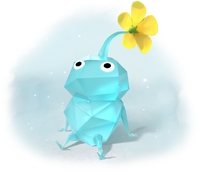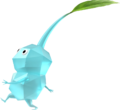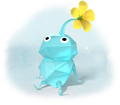Ice Pikmin
| |||
|---|---|---|---|

| |||
| Scientific name | Pikminidae habiglacius | ||
| Family | Pikmin | ||
| Resistance | Ice | ||
| Attack strength | Below average(?) | ||
| Mobility | Average | ||
| Throw | Average | ||
| Digging speed | Average | ||
| Carrying capacity | 1 | ||
| Pikmin 4 Piklopedia number | 118 | ||
Ice Pikmin (氷ピクミン?) are a type of Pikmin that appear in Pikmin 4 and Pikmin Bloom. They have light blue and blocky bodies, seemingly made of chunks of ice. Their defining characteristics are their immunity to all types of freezing, and their ability to freeze enemies and bodies of water and mud. They have lower attack power in battle, and burn to death faster than other Pikmin types when lit aflame by sources of fire. They leave small snow and water vapor particles around them as they move, and their buds and flowers are yellow.
Traits and abilities[edit]
- See more: Ice.

Ice Pikmin do not deal very much damage in combat. However, when attacking enemies, or when eaten by them, Ice Pikmin will progressively freeze them, which is represented by a ring-shaped gauge around the enemy's health wheel. Once the gauge is full, the enemy freezes entirely and can no longer act, though they do take reduced damage while frozen. Defeating a frozen enemy will make it shatter into chunks of ice without leaving a corpse, instead producing drops of nectar or ultra-spicy spray. Enemies that are frozen while in midair will fall to the ground and shatter, instantly defeating the enemy. If not defeated after 6 seconds (in Normal mode), a frozen enemy will begin shaking and eventually break out of the ice, shaking any attached Pikmin to the ground in the process.
Ice Pikmin can also be thrown into bodies of water or puddles of mud, making them the third type after Blue Pikmin and Bulbmin to be able to physically interact with water without suffering any harm; however, they lack the gills that Blue Pikmin possess, and are only able to float in the water, meaning they can neither breathe under nor swim in or explore the water as Blue Pikmin can. They are also susceptible to water-based attacks or other water hazards such as sprinklers, and if an enemy shakes an Ice Pikmin off and the Ice Pikmin lands in water, it will start drowning like Pikmin of most types.
If enough Ice Pikmin are thrown into a given body of water or mud, they will freeze it solid, allowing safe passage for other Pikmin types on the frozen surface. The water/mud will stay frozen for as long as the required number of Ice Pikmin stay rooted within. Ice Pikmin freezing a body of water/mud can be whistled out of it, and when there are no longer enough Ice Pikmin in a body of water/mud to keep it frozen, it will thaw out after a few seconds. How many Ice Pikmin are required to freeze a given body of water/mud can vary, mainly based on the size of the body in question, anywhere from 5 to 100. The required number is indicated in the HUD.
Ice Pikmin can resist icy hazards and attacks, and can attack cold enemies without being frozen solid. They also act normally in cold air without any help from a leader. However, they are more vulnerable than other types to fire, dying after 4 seconds instead of 6 (in Normal mode) when they are burnt by a fire hazard. Ice Pikmin that get trapped in bubbles will freeze the bubble and then quickly pop it.
In Pikmin 4[edit]
Discovery[edit]
Ice Pikmin are typically first discovered in the Last-Frost Cavern, where they are seen fighting a Snowy Blowhog that shoots ice. In their introduction cutscene, they spin around and slide on their lower bodies, meaning they are at least slightly slippery. Their Onion is not found until the Hero's Hideaway.
Required uses[edit]
- Dandori Challenges
- 3rd Story: Dig Deep: There is a narrow tunnel that leads to a Wayward Moon, and without Oatchi, the maximum carriers is 41. Oatchi also can't go out of bounds to get to the Wayward Moon without the narrow tunnel.
Recommended uses[edit]
Although not mandatory, Ice Pikmin are important in the completion of the following tasks:
- Treasures
 Aspiration-Ritual Pole: The treasure is found on a platform behind a hydro jelly. Alternatively, an Ice Blast can be used to freeze the hydro jellies, or with careful movements, Oatchi can walk around it.
Aspiration-Ritual Pole: The treasure is found on a platform behind a hydro jelly. Alternatively, an Ice Blast can be used to freeze the hydro jellies, or with careful movements, Oatchi can walk around it. Empty Vase: The treasure is found inside of a hydro jelly. Alternatively, an Ice Blast can be used to freeze the hydro jelly.
Empty Vase: The treasure is found inside of a hydro jelly. Alternatively, an Ice Blast can be used to freeze the hydro jelly. Mama Doll Head: The treasure is found on a raised platform beyond some water, which is easily accessible by freezing the water with 10 Ice Pikmin. Alternatively, Oatchi at Doggy-Paddle level 3 and Super Buff level 4 or higher, or Oatchi with Doggy-Paddle level 1 or higher and Blue Pikmin or Glow Pikmin can be used to reach the treasure.
Mama Doll Head: The treasure is found on a raised platform beyond some water, which is easily accessible by freezing the water with 10 Ice Pikmin. Alternatively, Oatchi at Doggy-Paddle level 3 and Super Buff level 4 or higher, or Oatchi with Doggy-Paddle level 1 or higher and Blue Pikmin or Glow Pikmin can be used to reach the treasure. Talisman of Life (Crane): The treasure is found inside of a hydro jelly. Alternatively, an Ice Blast can be used to freeze the hydro jelly.
Talisman of Life (Crane): The treasure is found inside of a hydro jelly. Alternatively, an Ice Blast can be used to freeze the hydro jelly.
- Enemies
 Blizzarding Blowhog: This enemy shoots out cold air fast and strong to the player, but can be defeated with any Pikmin type.
Blizzarding Blowhog: This enemy shoots out cold air fast and strong to the player, but can be defeated with any Pikmin type. Chillyhop: This enemy can create an cold spot on the ground when it lands back down after jumping, which can freeze non-Ice Pikmin, but can be defeated with any Pikmin type.
Chillyhop: This enemy can create an cold spot on the ground when it lands back down after jumping, which can freeze non-Ice Pikmin, but can be defeated with any Pikmin type. Dwarf Frosty Bulborb: This enemy has ice on its back, which can freeze non-Ice Pikmin, but it can also be defeated with Rock Pikmin and Purple Pikmin.
Dwarf Frosty Bulborb: This enemy has ice on its back, which can freeze non-Ice Pikmin, but it can also be defeated with Rock Pikmin and Purple Pikmin. Freezecake: This enemy's underside is covered with ice, so only Ice Pikmin and Glow Pikmin can attack this side, but its non-icy side can be attacked with any Pikmin type.
Freezecake: This enemy's underside is covered with ice, so only Ice Pikmin and Glow Pikmin can attack this side, but its non-icy side can be attacked with any Pikmin type. Frosty Bulborb: Like its dwarf counterpart, it too has ice on its back, which can freeze non-Ice Pikmin.
Frosty Bulborb: Like its dwarf counterpart, it too has ice on its back, which can freeze non-Ice Pikmin. Iceblown Dweevil: This enemy can freeze a large group of Pikmin at once, but can be defeated with any Pikmin type.
Iceblown Dweevil: This enemy can freeze a large group of Pikmin at once, but can be defeated with any Pikmin type. Icy Blowhog: This enemy shoots out cold air to freeze any Pikmin and can also make a cold spot on the ground temporarily, but can be defeated with any Pikmin type.
Icy Blowhog: This enemy shoots out cold air to freeze any Pikmin and can also make a cold spot on the ground temporarily, but can be defeated with any Pikmin type. Snowy Blowhog: This enemy shoots cold air towards the player, but can be defeated with any Pikmin type.
Snowy Blowhog: This enemy shoots cold air towards the player, but can be defeated with any Pikmin type. Ancient Sirehound: Its second phase involves ice attacks.
Ancient Sirehound: Its second phase involves ice attacks.
- Obstacles
 Hydro jelly: Hydro jellies can only be damaged while being frozen, which can be achieved by using either Ice Pikmin or an Ice Blast.
Hydro jelly: Hydro jellies can only be damaged while being frozen, which can be achieved by using either Ice Pikmin or an Ice Blast. Ice vent: While ice vents can be attacked by any Pikmin type, Ice Pikmin can attack the vent whether it is active or inactive as they cannot be frozen. The same goes for Glow Pikmin.
Ice vent: While ice vents can be attacked by any Pikmin type, Ice Pikmin can attack the vent whether it is active or inactive as they cannot be frozen. The same goes for Glow Pikmin. Ice wall: Due to their icy material, Ice Pikmin can attack these gates without getting frozen. Alternatively, a fire starter, Bomb Rock, Glow Pikmin, or Oatchi equipped with the
Ice wall: Due to their icy material, Ice Pikmin can attack these gates without getting frozen. Alternatively, a fire starter, Bomb Rock, Glow Pikmin, or Oatchi equipped with the  Pup Thermal Defense gear item can be used to destroy the gate.
Pup Thermal Defense gear item can be used to destroy the gate.
- Dandori Challenges
- Hefty Haulway: While Ice Pikmin are required in Single-Player Mode, the Pebble Pitcher can use Ice Blasts in Co-op Mode.
- Strategic Freezeway: Ice Pikmin will not stop in place, unlike Red Pikmin, but a platinum medal is still possible.
- 1st Story: Bulblaxes: While there is a Frosty Bulborb, it can be defeated with a Bomb Rock or the Pebble Pitcher.
- Final Story: The Purple Key: By cloning Purple Pikmin and using some Bomb Rocks from the Pebble Pitcher, it's possible to flatten the bag and transport the Purple Onion in time.
- Dandori Battles
- Battle in a Box: While Ice Pikmin are the only Pikmin supplied, Bonus Finds can be used to get a platinum medal.
- Others
 Castaway (Last-Frost Cavern): The castaway is found behind two hydro jellies. Alternatively, an Ice Blast can be used to freeze the hydro jellies. It is also possible to freeze this jelly by having Oatchi repeatedly rush the Refreshing Goo (or any other object) to position it behind the Snowy Blowhog, then slowly use it to push the Blowhog over to the hydro jellies. The Blowhog will then be able to freeze a hydro jelly, allowing the player to destroy it and access the castaway behind.[1]
Castaway (Last-Frost Cavern): The castaway is found behind two hydro jellies. Alternatively, an Ice Blast can be used to freeze the hydro jellies. It is also possible to freeze this jelly by having Oatchi repeatedly rush the Refreshing Goo (or any other object) to position it behind the Snowy Blowhog, then slowly use it to push the Blowhog over to the hydro jellies. The Blowhog will then be able to freeze a hydro jelly, allowing the player to destroy it and access the castaway behind.[1] Castaway (Aquiferous Summit): The castaway is found inside of an hydro jelly. Alternatively, an Ice Blast can be used to freeze the hydro jelly.
Castaway (Aquiferous Summit): The castaway is found inside of an hydro jelly. Alternatively, an Ice Blast can be used to freeze the hydro jelly.
The freezing ability of Ice Pikmin also makes them useful for enemies with moments of vulnerability. If timed correctly, they can be stuck in these moments longer than normal. Ice Pikmin are also useful as a backup in case an enemy ends up eating a lot of Pikmin. In that case, the enemy will be frozen, and the player will have a chance to either destroy the enemy or flee the battle. White Pikmin can also be used for a similar purpose, though they deal damage to the enemy rather than temporarily freezing it.
In Pikmin Bloom[edit]
In Pikmin Bloom, Ice Pikmin are the eighth and final Pikmin type unlocked, at level 13. Their seedlings require a minimum of 5 carrying strength to be retrieved, along with 5000 steps to grow. In expeditions, they have a carrying strength of 1 and a time modifier of 1. In mushroom battles, they have a base attack power of 2. Ice Pikmin were added to Pikmin Bloom on November 1st, 2025.[2]
Notes[edit]
Dalmo's notes[edit]
Olimar's notes[edit]
“Pikmin supposedly evolved from plants, yet there are also Pikmin species with bodies made of ice, known as Ice Pikmin. How is this possible?
The answer to this question lies in the fact that Ice Pikmin are parasitic by nature, and the ice serves as their host. The composition of this type of ice is, predictably, mostly water, but it resembles saline solution with faint concentrations of trace sodium ions, potassium ions, and calcium ions that function as neural transmitters.
Interestingly, the ice exhibits no visual signs of melting or dripping when exposed to sunlight. This is due to its low-temperature core, which continuously creates more ice in order to maintain a consistent size.”Louie's notes[edit]
Pikmin Bloom description[edit]
The official home for Pikmin (Pikmin series)[edit]
“Ice Pikmin belong to the parasitic Pikmin subtype called "Hermikmin." They acquire and maintain their bodies with a process that utilizes their low-temperature cores to constantly generate fresh ice from ambient moisture.
Freezing Properties
- Ice Pikmin freeze their prey by slamming against them with their frozen bodies. Ice Pikmin are buoyant in water and will float on the surface→ If enough gather, it is possible for them to freeze bodies of water
Cold Immunity
- Ice Pikmin are immune to cold temperatures and cannot be frozen. However, they are very vulnerable to fire and melt quickly. This means that when burnt, they will expire much faster than other Pikmin.”
The official home for Pikmin (Pikmin 4)[edit]
Pikmin Garden[edit]
Text
“ヤドリピクミンの一種。体内に低温の核を持ち、大気中の水分を凍らせてできた氷に寄生することで、体を獲得している。
特徴 その1 凍らせる
- 冷たい体で獲物をたたいて、凍らせてしまう。
- (Image text: 比重が軽いため、水に浮く → 数が集まれば、広い水場も凍らせてしまう)
特徴 その2 寒さに強い
- 寒さに強く、こごえることはない。
- (Image text: 火には弱く、他のピクミンが燃えるよりも速く溶けてしまう)”
Translation
“A kind of Hermikmin. It has a low-temperature core inside its body and acquires its body by parasitizing ice formed by freezing water in the atmosphere.
Feature #1: Freezing
- It strikes its prey with its cold body and freezes it.
- (Image text: "They float in the water due to their low relative density → When gathered in large numbers, they can freeze large bodies of water")
Feature #2: Resistant to cold
- It is resistant to cold and does not freeze.
- (Image text: "It is weak to fire and melts faster than other Pikmin burn")”
Technical information[edit]
| Pikmin 4 technical information (?) | |
|---|---|
| Attack strength | 5 |
| Carrying strength | 1 |
| Running speed | 140 leaf, 170 bud, 200 flower, 220 spicy |
| Digging speed | ≈1× the norm |
Naming[edit]
- See more: Pikmin family#Naming.
- Common name: Ice Pikmin.
- Japanese nickname: 氷ピクミン?, lit.: "Ice Pikmin".
- Japanese name: コオリヤドリピクミン?, lit.: "Ice-Dwelling Pikmin".
- Scientific name: Pikminidae habiglacius. Habiglacius is a combination of habitāre and glacius. Habitare is Latin for "to inhabit", while glacius is similar to glaciēs, meaning "ice".
- Internal names: Unknown.
- Prerelease: None.
Names in other languages[edit]
| Language | Name | Meaning |
|---|---|---|
| 氷ピクミン? Kōri Pikumin |
Ice Pikmin | |
(traditional) |
冰凍皮克敏 Bīngdòng Píkèmǐn |
Freeze Pikmin |
(simplified) |
冰冻皮克敏 Bīngdòng Píkèmǐn |
Freeze Pikmin |
| IJs-Pikmin | Ice Pikmin | |
| Pikmin glace | Ice Pikmin | |
| Eis-Pikmin | Ice Pikmin | |
| Pikmin gelato | Ice Pikmin | |
| 얼음피크민 Eoreum-Pikeumin |
Ice Pikmin | |
| Pikmin gelo | Ice Pikmin | |
| Pikmin gélido | Icy Pikmin | |
| Is-Pikmin | Ice Pikmin | |
| Jää-Pikmin | Ice Pikmin | |
| Is-Pikmin | Ice Pikmin |
Gallery[edit]
Pikmin 4[edit]
A render of the Ice Pikmin from the Pikmin Garden Piklopedia.
Ice Pikmin fighting against a Bulborb.
The Ice Pikmin's introduction cutscene in the Last-Frost Cavern.
Pikmin Bloom[edit]
The promotional image used on the blog post that announced Ice Pikmin would be coming to Pikmin Bloom.
Trivia[edit]
- Ice Pikmin are the first type of Pikmin with the ability to alter the environment.
- The Ice Pikmin's ability to freeze enemies is similar to ultra-bitter spray in Pikmin 2, though it involves ice instead of stone, and isn't instantaneous or able to hit multiple targets at once.
- White Pikmin and Ice Pikmin are the only types of Pikmin to use their specific resistant elements in combat, with White Pikmin poisoning enemies when eaten, and Ice Pikmin freezing them after a certain amount of hits or being eaten as well.
- Similar to Rock Pikmin, Ice Pikmin are referred to as parasitic. It is implied that they both belong to the same subset of Pikmin, known as "Hermikmin", which store their organs inside blocky, solid surfaces.[3] However, it would be inaccurate to label either of them as parasites, as they simply use an inanimate object as a vessel – similar to their subset's namesake, the hermit crab – and do not rely on other organisms.
- Not counting the Pikmin in Pikmin Bloom, Ice Pikmin are the first Pikmin whose flower color does not match the possible colors of the Bacopa Cabana.
- Ice Pikmin are the most frequently recommended Pikmin type for overground areas in Pikmin 4, being recommended in 5 of the game's 6 areas (every area except for the Giant's Hearth).
See also[edit]
References[edit]
- ^ YouTube video showing how to obtain the castaway in the Last-Frost Cavern without Ice Pikmin or an Ice Blast, published on August 20th, 2023, retrieved on March 8th, 2025
- ^ Cool News: Ice Pikmin Land in Pikmin Bloom on the Pikmin Bloom website, published on October 22nd, 2025, retrieved on October 25th, 2025
- ^ “The stone is actually the chosen host for a parasitic subset of Pikmin species nicknamed "Hermikmin." Similar to how a seed can sprout and push through the cracks of a rock, the Pikmin's roots stretch deep into the stone, storing its vital organs in an interior cavity that resembles a crystal geode.” – Captain Olimar in his entry on the Rock Pikmin in Pikmin 4.
| Pikmin | |
|---|---|
| Types | Red Pikmin • Yellow Pikmin • Blue Pikmin • Purple Pikmin • White Pikmin Rock Pikmin • Winged Pikmin • Ice Pikmin • Bulbmin • Glow Pikmin |
| Biology | Candypop Bud • Flarlic • Glow pellet • Idle • Lumiknoll • Maturity • Onion Pellet • Pikmin extinction • Trip • Sprout • Seedling • Soul • Squad |
| Abilities | Carry • Dig • Dodge • Fight • Hide |
| Controls | Charge • Dismiss • Swarm • Pluck • Throw • Whistle |
| Other | Decor Pikmin • Leafling • Mushroom Pikmin • Pikpik carrot |













